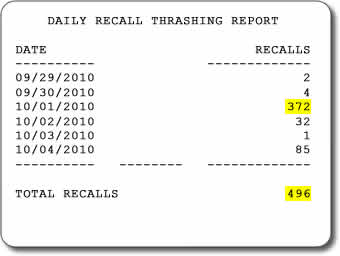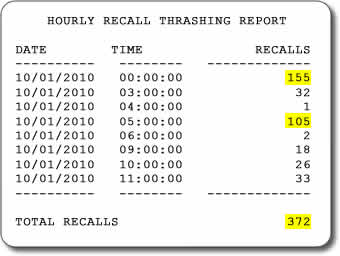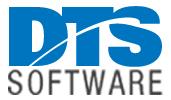Predictive Recall (MON-PRECALL)
- Eliminates production batch recalls, thus shortening the batch window
- Shifts recall processing to less-costly non-production times
- Allows more aggressive migration of unused data, reducing the need for more DASD
- Supports CA-7, Control-M, Zeke, and other schedulers
The Costly Problems
Unscheduled production dataset recalls will delay the production cycle since the job will be required to wait for the dataset to be recalled. The delay can be significant, especially for large files. If there is no VTS, there will be additional delays for tape location, mounting and dataset recovery.
To avoid these delays, a common and costly practice is to set high migration age levels to ensure the dataset will be available. This inefficient practice keeps production datasets unnecessarily on active DASD, resulting in higher storage costs.
With Predictive Recall, the migration age could be set efficiently, e.g., a few days. A dataset used infrequently will be migrated quickly, freeing up DASD space, and then later recalled by the Predictive Recall application shortly before it is actually needed.
How does it work?
-
The Job Scheduling software generates a list of the jobs for the Predictive Recall application to consider
-
The actual JCL used in the production jobs is obtained and the JCL is expanded to determine the fully qualified dataset names that will be used for the production run
-
A catalog lookup is issued for each input dataset, and a HRECALL statement is generated if the VOLSER is MIGRAT
-
The HRECALL statements are passed directly to the Inactive Data Mover to recall the dataset prior to the production cycle
What Job Schedulers are Supported?
The Predictive Recall software provides support for the major Job Schedulers: CA7, Control-M and . Additional job schedulers can be supported by sending DTS Software a sample scheduler report for the jobs that are scheduled to run during a batch window.
What Inactive Data Movers are Supported?
The application supports both DFHSM and FDR/ABR. If support for another Inactive Data Mover is required, a simple change to the Monitor control cards can be implemented to generate a different HRECALL command format.
The Recall Thrashing Reports
For DFHSM customers, MON-PRECALL provide reports showing the number of recalls occurring per hour throughout the day, or a daily summary report to target specific days of the month like month-end processing. The reports can be filtered to show only production recalls if those recalls can be identified by high level qualifier.


Avoids Production Delays
- Shortens batch window
- Avoids production delays due to recalls of migrated data
- Shifts recalls to lower utilization periods
- Allows more consistent batch run times
Reduces Storage Costs
- Migrate production data more aggressively
- Avoids inefficient practices of setting high migration age levels
- Large files can be sent directly to L2
- Effects “Just in Time” recall strategies
Supports Standard Utilities
- Utilizes existing Job Scheduler & Inactive Data Mover
- Supports CA7, Control-M, Zeke and more
- Supports DFHSM, FDR/ABR and more
Easy Problem Identification
- Thrashing Report quickly identifies severity and location of problem
- Multi-level reporting – high level daily report and detailed level hourly report
- Free report for DFHSM customers, with filtering available, will show thrashing activity
The marketing literature is available to all visitors. The product manuals are only available to registered customers and companies trialing DTS products – login is required. To request authorized access, please complete the Registration form. DTS customer support will review your request. Upon approval, you will receive access notification by E-mail within one business day.
| WEBINARS | |||
| Managing Your z_OS Storage Environment More Efficiently | Oct 25 2011 | 99.80 MB | 56 Minutes |
| MARKETING LITERATURE | |||
| Predictive Recall – Reduce Dataset Thrashing | Feb 26 2011 | 71.46 KB | |
| PRODUCT MANUALS | |||
| MON-PRecall User’s Guide | Mar 06 2017 | 242.21 KB | |
| MON-Snapshot User’s Guide | Mar 06 2017 | 1.65 MB | |
| Product Installation Guide | Nov 01 2018 | 1.04 MB | |
| Rule Language Programming Guide | May 24 2018 | 1.55 MB | |
| SCC Messages Manual | Nov 15 2018 | 1.02 MB |
“We have about 300 to 350 recalls done by Predictive Recall on a nightly basis. These numbers increase on a weekly and monthly cycle. On a daily cycle, we pre-call a few hundred datasets and shorten our production cycle by about 1.5 hours!
After a cycle has finished, our general DASD pool will be at 20% free space. We will then migrate datasets to obtain a free space of 50% or better in the pool. The use of Predictive Recall allows us to be aggressive with migration, thereby increasing free space in the pool.
We found Predictive Recall accurate and easy to use.”
Fortune 200 Insurance Company
Mainframe Storage Management Personnel
For the past several years, SCC Monitor customers have been using the product’s JCL scanning facility to perform predictive recall prior to running the production batch window. Some customers have achieved as much as a 90 minute reduction in the batch window by simply recalling all the migrated data sets before batch execution. In 2010, DTS decided to upgrade the feature to a product. A separate manual was written specifically for MON-PRECALL. Note: The new product does not require a MON-SNAPSHOT license.

